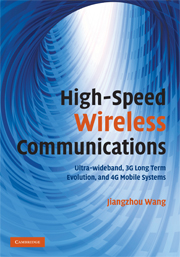Book contents
- Frontmatter
- Contents
- Preface
- Acknowledgements
- List of abbreviations
- Part I Introduction
- Part II UWB communications
- 2 Multicarrier CDMA overlay for UWB communications
- 3 Impulse radio overlay in UWB communications
- 4 Rapid acquisition
- Part III Evolved 3G mobile communications
- Part IV 4G mobile communications
- Index
- References
4 - Rapid acquisition
from Part II - UWB communications
Published online by Cambridge University Press: 27 May 2010
- Frontmatter
- Contents
- Preface
- Acknowledgements
- List of abbreviations
- Part I Introduction
- Part II UWB communications
- 2 Multicarrier CDMA overlay for UWB communications
- 3 Impulse radio overlay in UWB communications
- 4 Rapid acquisition
- Part III Evolved 3G mobile communications
- Part IV 4G mobile communications
- Index
- References
Summary
Ultra-wideband impulse radio is a promising radio technology for networks delivering extremely high data rates at short ranges. The use of extremely short duration pulses, however, makes the synchronization task more difficult. In this chapter a two-stage acquisition with serial search noncoherent correlator for time-hopping impulse radio is proposed. The proposed two-stage acquisition scheme gets chip timing synchronization, and aligns the phase of the local time-hopping code in two successive stages. With the aid of the flow-graph approach, analytical expressions are presented for the mean acquisition time and the probability of acquisition. Numerical results in a slow fading channel show that the proposed two-stage acquisition method can offer a much shorter mean acquisition time or much higher probability of acquisition than that delivered by conventional acquisition.
Introduction
As explained in Section 1.1, one of the design challenges provided by the wide bandwidth property of IR-UWB signals is timing acquisition, so a rapid acquisition algorithm is very important in IR-UWB communications. A few papers have focused on acquisition for TH IR-UWB signals. In [1] the authors analyze the acquisition performance of the IR-UWB signal. In [2] a generalized analysis of various serial search strategies is presented for reducing the mean acquisition time for IR-UWB signals in a dense multipath environment, and finally in [3] hybrid schemes for IR-UWB signal acquisition are proposed to trade off the speed of parallel schemes with the simplicity of serial search schemes.
- Type
- Chapter
- Information
- High-Speed Wireless CommunicationsUltra-wideband, 3G Long Term Evolution, and 4G Mobile Systems, pp. 92 - 114Publisher: Cambridge University PressPrint publication year: 2008



